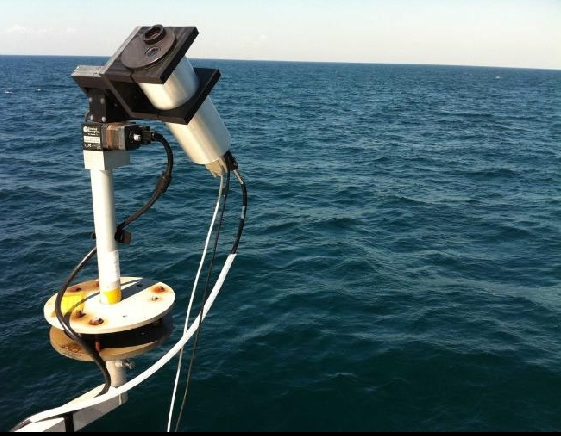Pandora-System Description
Pandora is a small spectrometer system based on commercial spectrometers having the stability and stray light characteristics that make them suitable candidates for direct-sun measurements of total columns of ozone and other trace gases in the atmosphere. Sky observations are also made for deriving trace gas altitude profiles (e.g., NO2 and O3). The Pandora spectrometer system uses a temperature stabilized (1OC) symmetric Czerny-Turner system over the range 280 – 525 nm (0.6 nm resolution with 4.5x oversampling) with a 2048 x 64 backthinned Hamamatsu CCD, 50 micron entrance slit, 1200 lines per mm grating, and fed light by a 400 micron core diameter fiber optic cable. The fiber optic cable obtains light from the sun, moon, or sky from front-end optics with a 2.2O field of view (FOV) for direct-sun observations using a diffuser and 1.6O FOV for sky observations without a diffuser. The optical head uses a double filter wheel containing 4 neutral density filters, a UV340 filter, a diffuser, and a blocked position. When combined with the variable exposure time (4 – 4000 ms), Pandora has a dynamic range of 107 to 1, which is sufficient for viewing both direct sun and sky, and for measuring the dark current in between each 20 second measurement (net measurement cadence is 80 seconds). On a clear-sky day, Pandora averages about 4000 direct-sun measurements in 20 seconds. The Pandora system is capable of both land-based and ship-board measurements.
While the current operational design is stable, there are improvements being made to the mechanical and optical design. In the near future, a new highly precise suntracker will replace the existing commercial design. A new optical head has been designed that permits the simultaneous operation of two spectrometers having different resolutions or different spectral ranges. The filter wheels inside the optical head can contain polarization filters to measure aerosol optical properties.
The included operation and automated data processing software is routinely upgraded as needed. Data processing into trace gas amounts is done after a day's measurements through an internet connection to each Pandora. NO2 and O3 data are available for scientific research purposes.
The Pandora Spectrometer System was originally developed at NASA's Goddard Space Flight Center with its first deployment in 2006 at the university in Thessaloniki, Greece. The Pandora system has undergone many design changes since then that have lead to a stable design capable of making unattended measurements over long periods. The instrument is capable of operating in a wide range of weather conditions with outdoors temperatures ranging from 10OF to 100OF.
The Pandora system is currently deployed in the US (Harvard Smithsonian in Boston, Goddard Space Flight Center in Greenbelt, Maryland, NASA Headquarters in Washington DC, NASA Langley Research Center in Langley Virginia, the University of Houston, Houston, Texas, Four Corners, New Mexico, and NOAA in Boulder, Colorado. There are also installations in Europe, Helsinki, Finland, Innsbruck, Austria, and the Canary Islands, and in Korea, Yonsei University in Seoul and Busan University in Pusan.
Pandora System on a Boat
A modified version of the Pandora system has been developed that can operate onboard a moving ship in the presence of moderate wave action while continuously tracking the sun. Sun-tracking is accomplished by using a small CCD camera inside the Pandora optical head to provide feedback the small suntracker shown in the picture. The key is in the software algorithm that continuously derives a boat-motion correction for the tracker to center and keep the sun centered in the Pandora's field of view. The software and camera have been significantly improved since the first deployment on the Chesapeake Bay (2009). The latest boat deployment in the Gulf of Mexico (DISCOVER-AQ Texas, 2013) was quite successful.
Shipping and Installation information
The Pandora system weighs about 80 pounds (36.4 kg) for shipping purposes. It can be shipped using most commercial shippers. The most frequent shipping container is a large cardboard box. If a tripod is required because there is no sturdy railing available, then a second box is required for shipping the tripod.
The Pandora system is installed so that the optical head can see the sun from as wide a sky angle as possible. The optical head is connected to a spectrometer using a 10 meter fiber optic cable and one RS232 cable and one power cable. The spectrometer is contained in a moderate size weatherproof box that occupies about 0.5 m2. The Pandora system needs either 110 volts or 220 volts, 500 watts power, and access to the internet (wired or wireless). The internet access must permit the use of commercial remote desktop control software (e.g., Logmein or TeamViewer) and ssh file moving software.
The moderate sized weatherproof box can be located indoors or outdoors, but works more easily in an indoors environment. The distance from the optical head is limited by the fiber optic cable to about 7 meters (23 feet). Special care must be applied for extreme conditions, such as very high humidity, very high (over 40OC) or very low (below -10OC) temperatures, if the box is located outdoors. The optical head can withstand most weather conditions.


Pandora operating in Cabauw, Netherlands 2009
Pandora on a boat in the Gulf of Mexico 2013

